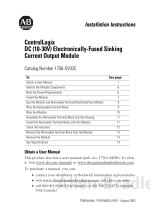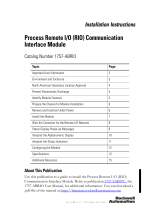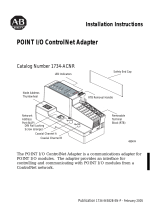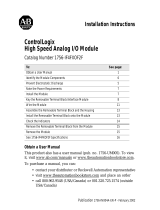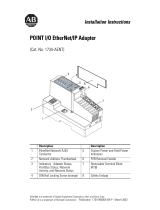La page est en cours de chargement...

Publication 1771ĆIN033B-EN-P - July 2002
DC (10Ć40V) Current Limiting
Output Module
Cat. No. 1771ĆOBDS
Use this document as a guide when installing the catalog number
1771-OBDS output module.
For information on: See page
Important User Information 1
Preinstallation Considerations 4
Calculate Power Requirements 4
Set the Fault Mode Selection Jumper 4
Key the Backplane Connector 5
Install the Module and Field Wiring Arm 6
Connect Wiring to the Output Module 7
Short Circuit Protection 10
Replacing the Fuse 11
For this reference information See page
Intepreting the Status Indicators 10
Hazardous Location Approval 12
Specifications 13
Because of the variety of uses for the products described in this
publication, those responsible for the application and use of these
products must satisfy themselves that all necessary steps have been
taken to assure that each application and use meets all performance
and safety requirements, including any applicable laws, regulations,
codes and standards. In no event will Rockwell Automation be
responsible or liable for indirect or consequential damage resulting
from the use or application of these products.
Any illustrations, charts, sample programs, and layout examples
shown in this publication are intended solely for purposes of
example. Since there are many variables and requirements associated
with any particular installation, Rockwell Automation does not
assume responsibility or liability (to include intellectual property
liability) for actual use based upon the examples shown in this
publication.
Important User Information
Installation Instructions
To The Installer

DC (10-40V) Current Limiting Output Module2
Publication 1771ĆIN033B-EN-P - July 2002
Allen–Bradley publication SGI–1.1, Safety Guidelines for
Application, Installation, and Maintenance of Solid–State Control
(available from your local Rockwell Automation office), describes
some important differences between solid–state equipment and
electromechanical devices that should be taken into consideration
when applying products such as those described in this publication.
Reproduction of the contents of this copyrighted publication, in
whole or part, without written permission of Rockwell Automation,
is prohibited.
Throughout this publication, notes may be used to make you aware
of safety considerations. The following annotations and their
accompanying statements help you to identify a potential hazard,
avoid a potential hazard, and recognize the consequences of a
potential hazard.
WARNING
!
Identifies information about practices or
circumstances that can cause an explosion in a
hazardous environment, which may lead to
personal injury or death, property damage, or
economic loss.
ATTENTION
!
Identifies information about practices or
circumstances that may lead to personal injury or
death, property damage, or economic loss.
IMPORTAN
T
Identifies information that is critical for
successful application and understanding of the
product.

DC (10-40V) Current Limiting Output Module 3
Publication 1771ĆIN033B-EN-P - July 2002
ATTENTION
!
Environment and Enclosure
This equipment is intended for use in a Pollution
Degree 2 industrial environment, in overvoltage
Category II applications (as defined in IEC
publication 60664–1), at altitudes up to 2000
meters without derating.
This equipment is considered Group 1, Class A
industrial equipment according to IEC/CISPR
Publication 11. Without appropriate precautions,
there may be potential difficulties ensuring
electromagnetic compatibility in other
environments due to conducted as well as radiated
disturbance.
This equipment is supplied as “open type”
equipment. It must be mounted within an
enclosure that is suitably designed for those
specific environmental conditions that will be
present, and appropriately designed to prevent
personal injury resulting from accessibility to live
parts. The interior of the enclosure must be
accessible only by the use of a tool. Subsequent
sections of this publication may contain additional
information regarding specific enclosure type
ratings that are required to comply with certain
product safety certifications.
See NEMA Standards publication 250 and IEC
publication 60529, as applicable, for explanations
of the degrees of protection provided by different
types of enclosures. Also, see the appropriate
sections in this publication, as well as the
Allen–Bradley publication 1770–4.1, (“Industrial
Automation Wiring and Grounding Guidelines”),
for additional installation requirements pertaining
to this equipment.

DC (10-40V) Current Limiting Output Module4
Publication 1771ĆIN033B-EN-P - July 2002
!
ATTENTION
Preventing Electrostatic Discharge
This equipment is sensitive to electrostatic
discharge, which can cause internal damage and
affect normal operation. Follow these guidelines
when you handle this equipment:
• Touch a grounded object to discharge potential
static.
• Wear an approved grounding wriststrap.
• Do not touch connectors or pins on component
boards.
• Do not touch circuit components inside the
equipment.
• If available, use a static–safe workstation.
• When not in use, keep modules in appropriate
static–safe packaging.
This module must be used with a 1771-A1B thru -A4B or later I/O
chassis. Make sure no other output module or single card block
transfer module is placed in the same module group when using
2-slot addressing.
Your module receives its power through the 1771 I/O chassis
backplane from the chassis power supply. The module requires
300mA from the output of this supply. Add this to the requirements
of all other modules in the I/O chassis to prevent overloading the
chassis backplane and/or backplane power supply.
You may select one of two input-failure configurations (last state or
reset) by positioning a configuration plug on the bottom edge of the
printed circuit board. This configuration plug is independent of the
last state switch on the I/O chassis backplane.
To set the fault mode selection, proceed as follows:
1. Locate the fault mode selection plug at the bottom edge of the
module circuit board.
LS RESET
Fault Mode Selection Plug
Bottom edge of circuit board
(shown in last state position)
10418ĆI
2. Using your finger, slide the plug off the two posts.
3. Carefully position the plug on two of the three posts that
correspond to your requirement.
PreĆinstallation
Considerations
Calculate Power
Requirements
Set the Fault Mode
Selection Jumper

DC (10-40V) Current Limiting Output Module 5
Publication 1771ĆIN033B-EN-P - July 2002
!
ATTENTION
A module inserted into a wrong slot could be
damaged by improper voltages connected through
the wiring arm. Use keying bands to prevent
damage to the module.
Place your module in any slot in the chassis
except the leftmost slot, which is reserved for
processors or adapters.
Observe the following precautions
when inserting or removing keys:
• insert or remove keys with your
fingers
• make sure that key placement is
correct
Incorrect keying or the use of a tool
can result in damage to the
backplane connector and possible
system faults.
!
ATTENTION
Position the keying bands in the backplane connectors to correspond to
the key slots on the module.
You can change the position of these bands if
subsequent system design and rewiring makes
insertion of a different type of module necessary.
Upper Connector
11022ĆI
I/O chassis
Place the keying bands:
- between 10 and 12
- between 22 and 24
Key the Backplane
Connector

DC (10-40V) Current Limiting Output Module6
Publication 1771ĆIN033B-EN-P - July 2002
!
WARNING
When you insert or remove the module while
backplane power is on, or you connect or
disconnect the wiring arm with field power
applied, an electrical arc can occur. This could
cause an explosion in hazardous location
installations. Be sure power is removed or the area
is nonhazardous before proceeding.
!
ATTENTION
Remove power from the 1771 I/O chassis
backplane and field wiring arm before removing
or installing an I/O module.
• Failure to remove power from the backplane or
wiring arm could cause module damage, degra-
dation of performance, or injury.
• Failure to remove power from the backplane
could cause injury or equipment damage due to
possible unexpected operation.
Swing the chassis locking bar down into place to secure
the modules. Make sure the locking pins engage.
1771ĆA1B, ĆA2B, ĆA3B, ĆA3B1, ĆA4B I/O chassis
1771ĆA1B, ĆA2B, ĆA3B1, ĆA4B Series B I/O chassis
locking tab
card guides
module
module
19809
card guides
locking bar
locking bar pin
Snap the chassis latch over
the top of the module to secure it.
17643
wiring arm
install
remove
horizontal bar
Attach the wiring arm (1771ĆWH) to the horizontal
bar at the bottom of the I/O chassis.
The wiring arm pivots upward and connects with
the module so you can install or remove the
module without disconnecting the wires.
1771ĆWH
The 1771–OBDS module is a modular component of the 1771 I/O
system requiring a properly installed system chassis. Refer to
publication 1771–IN075 for detailed information on acceptable
chassis, proper installation and grounding requirements. Limit the
maximum adjacent slot power dissipation to 10W maximum.
Install the Module and Field
Wiring Arm

DC (10-40V) Current Limiting Output Module 7
Publication 1771ĆIN033B-EN-P - July 2002
!
ATTENTION
Remove power from the 1771 I/O chassis
backplane and field wiring arm before removing
or installing an I/O module.
• Failure to remove power from the backplane or
wiring arm could cause module damage,
degradation of performance, or injury.
• Failure to remove power from the backplane
could cause injury or equipment damage due to
possible unexpected operation.
Make wiring connections to the 21 terminal field wiring arm (cat. no.
1771-WH) shipped with the module.
Attach the wiring arm to the pivot bar on the bottom of the I/O
chassis. The wiring arm pivots upward and connects with the module
so you can install or remove the module without disconnecting the
wires.
!
WARNING
When you insert or remove the module while
backplane power is on, or you connect or
disconnect the wiring arm with field power
applied, an electrical arc can occur. This could
cause an explosion in hazardous location
installations. Be sure power is removed or the area
is nonhazardous before proceeding.
Connect Wiring to the
Output Module

DC (10-40V) Current Limiting Output Module8
Publication 1771ĆIN033B-EN-P - July 2002
Actual wiring runs in this direction.
Output 00
Output 01
Output 02
Output 03
Output 04
Output 05
Output 06
Output 07
Output 10
Output 11
Output 12
Output 13
Output 14
Output 15
Output 16
Output 17
Output
Device
dc
User
dc
Supply
+dc
Ćdc
+dc
+dc
+dc
+
+
Ć
Ć
A
B
C
D
01
02
03
04
05
06
07
10
11
12
13
14
15
16
17
00
E
10419ĆI
You must supply dc at terminals A through D on the wiring arm. You
need four dc connections to accommodate the total required surge
rating on the module without overstressing any single connection on
the field wiring arm. Jumper all dc connections together to prevent
module damage. Connect terminal E to dc common.
!
ATTENTION
Observe proper polarity, as indicated in the
connection diagram with dc power connections.
Reverse polarity, or application of ac voltage,
could damage the module.

DC (10-40V) Current Limiting Output Module 9
Publication 1771ĆIN033B-EN-P - July 2002
IMPORTANT
You can use a DC (10-40V) Output Module (cat.
no. 1771-OBDS) to directly drive terminals on
the following modules:
• DC (10-30V) Input module (cat. no.
1771-IBD)
• DC (20-60V) Input module (cat. no.
1771-ICD)
• DC (12-24V) Input module (cat. no. 1771-IB)
See below for direct connection to a 1771-ICD
input module.
Use the same dc supply to power both
modules to ensure that ground is at the same
potential.
Driving an Input Module with an Output Module
DC (10Ć40V) Current Limiting Output Module
(Cat. No. 1771ĆOBDS) (Cat. No. 1771ĆICD)
DC (20Ć60V) Input Module
10Ć40V dc
Output 00
Output 01
Output 02
Output 03
Output 04
Output 05
Output 06
Output 07
Output 10
Output 11
Output 12
Output 13
Output 14
Output 15
Output 16
Output 17
+dc
Ćdc
+dc
+dc
+dc
Input 00
Input 01
Input 02
Input 03
Input 04
Input 05
Input 06
Input 07
Input 10
Input 11
Input 12
Input 13
Input 14
Input 15
Input 16
Input 17
Not used
dc Common
Not used
Not used
Not used
Actual wiring runs in this direction.
10420ĆI

DC (10-40V) Current Limiting Output Module10
Publication 1771ĆIN033B-EN-P - July 2002
Each output of the module is capable of withstanding a short circuit
condition. When an output is shorted, it will become ”latched off,”
but its corresponding status indicator will remain lighted. Once the
short circuit is removed from that output, the output image table bit
for that output must be reset by ”toggling” the bit off and then back
on. This resumes normal operation. This toggling procedure can be
done several ways, depending on your system setup:
• modifying the data table
• switching the programmable controller from RUN to PROGRAM
mode, and back again
• cycling power to the system.
The front panel of your module contains one green module active
indicator, 16 red status indicators and one red fuse blown indicator.
The green module active indicator lights when the module is
powered, the processor keyswitch is on ”run”, and the opto-isolators
and data paths are functioning properly. It turns off if a fault occurs
in the data paths or the opto-isolators. The module then resets its
outputs or sets them to last state.
The module active indicator must be on to properly interpret the red
status indicators. The red status indicators are provided for indication
of individual outputs. They indicate the state to which the transistor
is commanded by the processor and are powered by circuitry within
the module. The indicators will turn on and off as commanded by the
processor. They do not indicate the presence or absence of dc power
at an output terminal. However, all output status indicators will turn
off if the fuse is blown.
The fuse blown indicator turns on when the fuse is blown. When the
fuse blown indicator is lit, check the fuse. After checking the fuse,
make sure the field wiring arm is firmly in place. Do this before
checking the status of the other indicators.
ACTIVE
00
01
02
03
04
05
06
07
10
11
12
13
14
15
16
17
Module Active
Indicator (green)
00 to 17 Status
Indicators (red)
FUSE
Fuse Blown
Indicator (red)
10421ĆI
Short Circuit Protection
Interpreting the Status
Indicators

DC (10-40V) Current Limiting Output Module 11
Publication 1771ĆIN033B-EN-P - July 2002
The individual output transistors are thermally protected against
overcurrent or overtemperature conditions. However, a module
overload may cause the single, replaceable onboard fuse to blow
when the module output exceeds 12A. The onboard fuse is not
intended to protect individual output transistors. You can replace the
onboard fuse as outlined below.
1. Turn off all power to the I/O chassis and all output device power
to the field wiring arm.
ATTENTION
!
Remove power from the 1771 I/O chassis
backplane and wiring arm before removing or
installing the module.
• Failure to remove power from the backplane or
field wiring arm could cause module damage,
degradation of performance, or injury.
• Failure to remove power from the backplane
could cause injury or equipment damage due to
possible unexpected operation.
2. Remove the module from the chassis and replace the blown fuse
with a 12A, 250V rectifier fuse (1/4 x 1-1/4 inch), Bussman part
number GBB12. The fuse is accessible through the side of the
module.
3. Replace the module in the chassis and attach the field wiring arm.
4. Turn system power ON.
Replacing the Fuse

DC (10-40V) Current Limiting Output Module12
Publication 1771ĆIN033B-EN-P - July 2002
The following information applies when operating this equipment in hazardous
locations:
Products marked CL I, DIV 2, GP A, B, C, D" are suitable for use in Class I Division 2
Groups A, B, C, and D Hazardous Locations and nonhazardous locations only. Each
product is supplied with markings on the rating nameplate indicating the hazardous location
temperature code. When combining products within a system, the most adverse
temperature code (lowest T" number) may be used to help determine the overall
temperature code of the system. Combinations of equipment in your system are subject to
investigation by the local Authority Having Jurisdiction at the time of installation.
!
WARNING
EXPLOSION HAZARD -
• Do not disconnect equipment unless power has been removed or
the area is known to be nonhazardous.
• Do not disconnect connections to this equipment unless power
has been removed or the area is known to be nonhazardous.
Secure any external connections that mate to this equipment by
using screws, sliding latches, threaded connectors, or other
means provided with this product.
• Substitution of components may impair suitability for Class I,
Division 2.
• If this product contains batteries, they must only be changed in an
area known to be nonhazardous.
Informations sur l'utilisation de cet équipement en environnements dangereux:
Les produits marqués CL I, DIV 2, GP A, B, C, D ne conviennent que une utilisation en
environnements de Classe I Division 2 Groupes A, B, C, D dangereux et non dangereux.
Chaque produit est livré avec des marquages sur sa plaque d'identification qui indiquent le
code de température pour les environnements dangereux. Lorsque plusieurs produits sont
combinés dans un systéme, le code de température le plus défavorable (code de
température le plus faible) peut eatre utilisé pour déterminer le code de température global
du systéme. Les combinaisons d'equipements dans le systéme sont sujettes à inspection
par les autorités locales qualifiées au moment de l'installation.
!
AVERTISSEMENT
RISQUE D'EXPLOSION -
• Couper le courant ou s'assurer que l'environnement est classé
non dangereux avant de débrancher l'équipement.
• Couper le courant ou s'assurer que l'environnement est classé
non dangereux avant de débrancher les connecteurs. Fixer tous
les connecteurs externes reliés à cet équipement à
l'aide de vis, loquets coulissants, connecteurs filetés ou autres
moyens fournis avec ce produit.
• La substitution de composants peut rendre cet équipement
inadapté à une utilisation en environnement de Classe 1, Division
2.
• S'assurer que l'environnement est classé non dangereux avant
de changer les piles.
PLC-2/02, PLC-2/05, PLC-2/16, and PLC-2/17 are trademarks of Allen-Bradley Company, Inc.

DC (10-40V) Current Limiting Output Module 13
Publication 1771ĆIN033B-EN-P - July 2002
Outputs per Module 16
Module Location 1771ĆA1B, thru ĆA4B or later I/O chassis
Output Voltage Range 10 to 40V dc
Output Current Rating 1A per output Ć not to exceed 8A per module, Pilot duty.
See derating curve below.
On State Voltage Drop (max.) 1.5V at rated current
Off State Leakage Current (max.) 0.5mA per output
Signal Delay Off to On
On to Off
1.0ms
1.0ms
Power Dissipation 14 Watts (max.), 2 Watts (min.)
Power Dissipation - adjacent slot 10 Watts (max.)
Thermal Dissipation 47.8 BTU/hr (max.), 6.9 BTU/hr (min.)
Backplane Current 300mA @ 5V dc +5%
Isolation Voltage Tested to withstand 500V for 60s.
Conductors Wire Size
Category
14 AWG (2.5mm
2
) stranded copper rated at 60
o
C or greater
3/64 inch (1.2mm) insulation (max)
2
1
Environmental Conditions
Operating
Temperature
IEC 60068-2-1 (Test Ad, Operating Cold)
IEC 60068-2-2 (Test Bd, Operating Dry Heat)
IEC 60068-2-14 (Test Nb, Operating Thermal Shock)
32 to 140°F(0
o
to 60
o
C)
Storage Temperature IEC 60068-2-1 (Test Ab, Unpackaged, Nonoperating Cold)
IEC 60068-2-2 (Test Bb, Unpackaged, Nonoperating Dry Heat)
IEC 60068-2-14 (Test Na, Unpackaged, Nonoperating Thermal
Shock)
-40 to 185°F (-40 to 85
o
C)
Relative Humidity IEC 60068-2-30 (Test Db, Unpackaged, Nonoperating Damp Heat)
5 to 95%, noncondensing
Shock
Operating
Nonoperating
IEC 60068-2-27 (Test Ea, Unpackaged Shock)
30g
50g
Vibration IEC 60068-2-6 (Test Fc, Operating)
2g @ 10-500Hz
ESD Immunity IEC 61000-4-2
4kV indirect discharges
Radiated RF Immunity IEC 61000-4-3
10V/m, with 1kHz sine-wave 80% AM from 30MHz to 1000MHz
EFT/B Immunity IEC 61000-4-4
+
1kV @ 5kHz on signal ports
Surge Transient Immunity IEC 61000-4-5
+
1kV line-line (DM) and +2kV line-earth (CM) on signal ports
Conducted RF Immunity IEC 61000-4-6
10V rms with 1kHz sine wave 80% AM from 150kHz to 30MHz
Emissions CISPR 11
Group 1, Class A (with appropriate enclosure)
Enclosure Type Rating None (open-style)
Specifications

DC (10-40V) Current Limiting Output Module14
Publication 1771ĆIN033B-EN-P - July 2002
Keying Between 10 and 12
Between 22 and 24
Fuse 12A, 250V rectifier fuse (1/4 x 1Ć1/4 inch), Bussman GBB12, IEC 127
Type F (black)
Field Wiring Arm Catalog Number 1771ĆWH
Wiring Arm Screw Torque 9 pound-inches (1.0Nm)
Agency Certification
(when product is marked)
UL UL Listed Industrial Control Equipment
CSA CSA Certified Process Control Equipment
CSA CSA Certified Process Control Equipment for Class I,
Division 2 Group A, B, C, D Hazardous Locations
CE
2
European Union 89/336/EEC EMC Directive,
compliant with:
EN 50082-2, Industrial Immunity
EN 61236, Meas./Control/Lab., Industrial Requirements
EN 61000-6-2, Industrial Immunity
EN 61000-6-4, Industrial Emissions
EEx
2
European Union 94/9/EEC ATEX Directive, compliant with:
EN 50021, Potentially Explosive Atmospheres, Protection n"
C-Tick
2
Australian Radiocommunications Act, compliant with:
AS/NZS 2064, Industrial Emissions
1
You use this conductor category information for planning conductor routing as described in publication 1770Ć4.1, Industrial
Automation Wiring and Grounding Guidelines.
2
See the Product Certification link at www.ab.com for Declarations of Conformity, Certificates and other certification details
European Zone 2 Certification
This equipment is intended for use in potentially explosive atmospheres as defined by European
Union Directive 94/9/EC.
The LCIE (Laboratoire Central des Industries Electriques) certifies that this equipment has been
found to comply with the Essential Health and Safety Requirements relating to the design and
construction of Category 3 equipment intended for use in potentially explosive atmospheres,
given in Annex II to this Directive. The examination and test results are recorded in confidential
report No. 28 682 010.
Compliance with the Essential Health and Safety Requirements has been assured by
compliance with EN 50021 (1999).
IMPORTANT
Observe the following additional Zone 2 certification requirements:
• This equipment is not resistant to sunlight or other sources of UV
radiation.
• The secondary of a current transformer shall not be open-circuited when
applied in Class I, Zone 2 environments.
• Equipment of lesser Enclosure Type Rating must be installed in an
enclosure providing at least IP54 protection when applied in Class I, Zone
2 environments.
• This equipment shall be used within its specified ratings defined by
Allen-Bradley.
• Provision shall be made to prevent the rated voltage from being exceeded
by transient disturbances of more than 40% when applied in Class I, Zone
2 environments.

DC (10-40V) Current Limiting Output Module 15
Publication 1771ĆIN033B-EN-P - July 2002
Derating Curve for the 1771-OBDS
0
1
2
3
4
5
6
7
8
9
010 203040 5060
Temperature (
o
C)
I
Module
- Amperes

DC (10-40V) Current Limiting Output Module16
Publication 1771ĆIN033B-EN-P - July 2002
Publication 1771ĆIN033B-EN-P - July 2002
Supersedes publication 1771Ć5.33 - October 1995
PN957689-07
Copyright 2002 Rockwell Automation Inc. Printed in USA
1/16


